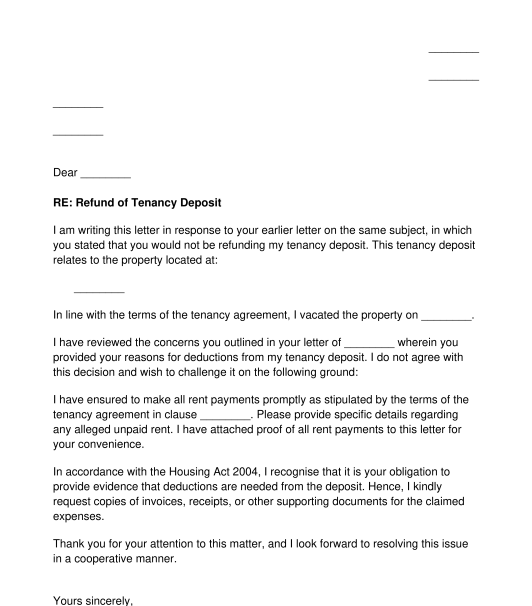 21/09/2025
21/09/2025

Answer a few questions and your document is created automatically.

Your document is ready! You will receive it in Word and PDF formats. You will be able to modify it.

 21/09/2025
21/09/2025
 Word and PDF
Word and PDF
 1 page
1 page
A Tenant of a residential property can use this letter to challenge a Landlord's decision to withhold the Tenant's deposit at the end of the tenancy period. In this letter, the Tenant will explain to the Landlord the reasons why the withholding of the deposit is incorrect.
No, it is not mandatory to send a letter to a landlord challenging their decision to withhold a deposit, but it is highly recommended for documentation purposes. In England and Wales, the Housing Act 2004 requires landlords to protect tenants' deposits in an approved scheme and to provide clear reasons and evidence, such as inventories or receipts, for any deductions made from the deposit.
Once the letter challenging the deposit withholding is ready, ensure it includes relevant details and supporting evidence like the tenancy agreement and inventory reports. Deliver it via recorded mail or email for proof of receipt, and keep copies for your records. Allow the landlord time to respond, and if unresolved, escalate to a tenancy deposit protection scheme or dispute resolution service.
A landlord may withhold a tenant's deposit in situations such as unpaid rent, property damage, cleaning costs, or other claims related to the tenant's actions or failure to meet the terms of the tenancy agreement. These reasons must be clearly justified, with supporting evidence, in accordance with the requirements set out by the Housing Act 2004.
A letter from a tenant challenging a landlord's withhold deposit must include:
You fill out a form. The document is created before your eyes as you respond to the questions.
At the end, you receive it in Word and PDF formats. You can modify it and reuse it.
Country: United Kingdom